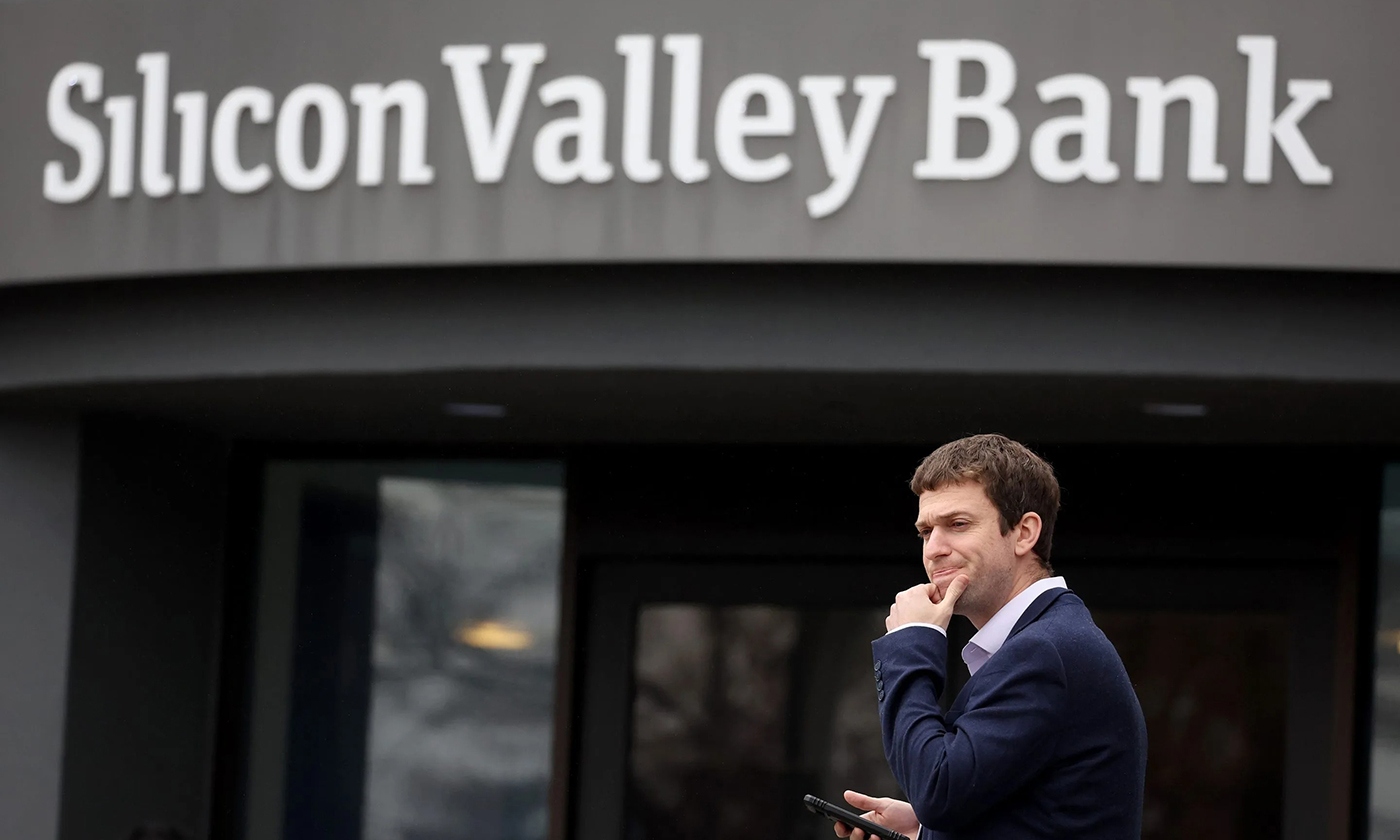一项大规模研究发现,社交媒体刺激了银行挤兑

1982年,位于美国俄克拉何马州的佩恩广场银行(Penn Square Bank)倒闭后,俄亥俄州的共和党众议员埃德·韦伯在听证会上谴责监管部门,称该银行的倒闭是“对监管系统的控诉”。但负责审计佩恩广场银行的美国货币监理署(Comptroller of the Currency)的官员进行反驳,并指责其他监管部门和银行管理层依赖高风险的能源贷款。
听起来很熟悉吗?今年3月,硅谷银行(Silicon Valley Bank)和签名银行(Signature Bank)倒闭后,南卡罗来纳州的共和党众议员蒂姆·斯科特在听证会上对监管部门表示,在这些银行的问题最近曝光之前,他们“似乎在方向盘上睡着了”。监管部门如何回应?他们指责银行高管,美联储(Federal Reserve)的监管副主席迈克尔·S.巴尔对参议院表示,硅谷银行倒闭是“管理不善的典型教学案例”。
历史上每一次银行倒闭之后,都会上演这种相互指责的把戏,先是政客们在国会抨击监管部门,指责他们没有发现本来可以避免银行倒闭的警告信号,而监管部门则将矛头指向了贪婪的银行家。
虽然这听起来有些老套,但这一次的情况有所不同。两党都认为,此次银行倒闭危机有一个新的帮凶,那就是社交媒体。正如科罗拉多州立大学(Colorado State University)的经济学教授斯蒂芬·维勒在今年3月告诉《财富》杂志的,硅谷银行的储户集中于科技行业,他们精通社交媒体,这意味着“他们有巨大的能力,在48小时内取光[银行]可用的所有现金。”现在,有来自五所大学的教授在一份最新研究里证实,“社交媒体确实刺激了硅谷银行挤兑。”
学者们警告:“更重要的是,我们的分析表明,其他银行面临类似风险。”他们认为社交媒体是“引发银行挤兑风险的新渠道”。
新技术意味着新风险
许多银行的首席执行官和经济学家们很快将今年3月硅谷银行的倒闭,描述成史上首次社交媒体银行挤兑。彭博社(Bloomberg)报道称,人脉广泛的风险投资者利用私密通信平台和电子邮件,警告其他人他们最喜欢的贷款人面临的问题,这加剧了银行挤兑。花旗集团(Citigroup)的首席执行官简·弗雷泽在3月23日接受采访时谈到了社交媒体刺激银行挤兑的问题,她说:“从我们以前的经历来看,社交媒体产生了根本性的影响。”
尽管社交媒体遭到各种指责,但没有任何确切证据,能够证明社交媒体对硅谷银行的影响。不过现在,包括科罗拉多大学水牛城分校(University of Colorado at Boulder)的J·安东尼·库克森、詹姆斯·麦迪逊大学(James Madison University)的科尔宾·福克斯、庞培法布拉大学(Universitat Pompeu Fabra)的贾维尔·吉尔-巴佐、巴黎第九大学(Université Paris Dauphine)的胡安·菲利佩·伊姆拜特和亚利桑那州立大学(Arizona State University)的克里斯多夫·希勒等多位教授,在一项名为“社交媒体作为银行挤兑催化剂”(Social Media as a Bank Run Catalyst)的研究中,合作分析了自今年年初至3月14日约540万条谈论上市银行股票的推文。
通过对比存在银行挤兑风险的股票回报率与谈论该银行的负面推文数量,他们发现,在“推特(Twitter)上讨论热烈的时候”,如果一家银行被反复提及,银行挤兑的风险“会大幅提高”。
这项研究还通过分析数百名创业圈成员发布的推文,证实了风险投资者和初创公司创始人在银行挤兑中扮演的角色。与创业圈挂钩的银行挤兑风险更高,尤其是当储户没有保险时。初创公司创始人和风险投资者表达负面情绪的推文,在发布后5分钟至15分钟的研究期限内,对银行股票收益率产生了“严重的负面影响”。
教授们最后表示:“无论在推特上还是其他平台,社交沟通变得日益普遍,因此我们预计这种风险不会消失,相反,它可能还会影响其他结果。”(财富中文网)
翻译:刘进龙
审校:汪皓
1982年,位于美国俄克拉何马州的佩恩广场银行(Penn Square Bank)倒闭后,俄亥俄州的共和党众议员埃德·韦伯在听证会上谴责监管部门,称该银行的倒闭是“对监管系统的控诉”。但负责审计佩恩广场银行的美国货币监理署(Comptroller of the Currency)的官员进行反驳,并指责其他监管部门和银行管理层依赖高风险的能源贷款。
听起来很熟悉吗?今年3月,硅谷银行(Silicon Valley Bank)和签名银行(Signature Bank)倒闭后,南卡罗来纳州的共和党众议员蒂姆·斯科特在听证会上对监管部门表示,在这些银行的问题最近曝光之前,他们“似乎在方向盘上睡着了”。监管部门如何回应?他们指责银行高管,美联储(Federal Reserve)的监管副主席迈克尔·S.巴尔对参议院表示,硅谷银行倒闭是“管理不善的典型教学案例”。
历史上每一次银行倒闭之后,都会上演这种相互指责的把戏,先是政客们在国会抨击监管部门,指责他们没有发现本来可以避免银行倒闭的警告信号,而监管部门则将矛头指向了贪婪的银行家。
虽然这听起来有些老套,但这一次的情况有所不同。两党都认为,此次银行倒闭危机有一个新的帮凶,那就是社交媒体。正如科罗拉多州立大学(Colorado State University)的经济学教授斯蒂芬·维勒在今年3月告诉《财富》杂志的,硅谷银行的储户集中于科技行业,他们精通社交媒体,这意味着“他们有巨大的能力,在48小时内取光[银行]可用的所有现金。”现在,有来自五所大学的教授在一份最新研究里证实,“社交媒体确实刺激了硅谷银行挤兑。”
学者们警告:“更重要的是,我们的分析表明,其他银行面临类似风险。”他们认为社交媒体是“引发银行挤兑风险的新渠道”。
新技术意味着新风险
许多银行的首席执行官和经济学家们很快将今年3月硅谷银行的倒闭,描述成史上首次社交媒体银行挤兑。彭博社(Bloomberg)报道称,人脉广泛的风险投资者利用私密通信平台和电子邮件,警告其他人他们最喜欢的贷款人面临的问题,这加剧了银行挤兑。花旗集团(Citigroup)的首席执行官简·弗雷泽在3月23日接受采访时谈到了社交媒体刺激银行挤兑的问题,她说:“从我们以前的经历来看,社交媒体产生了根本性的影响。”
尽管社交媒体遭到各种指责,但没有任何确切证据,能够证明社交媒体对硅谷银行的影响。不过现在,包括科罗拉多大学水牛城分校(University of Colorado at Boulder)的J·安东尼·库克森、詹姆斯·麦迪逊大学(James Madison University)的科尔宾·福克斯、庞培法布拉大学(Universitat Pompeu Fabra)的贾维尔·吉尔-巴佐、巴黎第九大学(Université Paris Dauphine)的胡安·菲利佩·伊姆拜特和亚利桑那州立大学(Arizona State University)的克里斯多夫·希勒等多位教授,在一项名为“社交媒体作为银行挤兑催化剂”(Social Media as a Bank Run Catalyst)的研究中,合作分析了自今年年初至3月14日约540万条谈论上市银行股票的推文。
通过对比存在银行挤兑风险的股票回报率与谈论该银行的负面推文数量,他们发现,在“推特(Twitter)上讨论热烈的时候”,如果一家银行被反复提及,银行挤兑的风险“会大幅提高”。
这项研究还通过分析数百名创业圈成员发布的推文,证实了风险投资者和初创公司创始人在银行挤兑中扮演的角色。与创业圈挂钩的银行挤兑风险更高,尤其是当储户没有保险时。初创公司创始人和风险投资者表达负面情绪的推文,在发布后5分钟至15分钟的研究期限内,对银行股票收益率产生了“严重的负面影响”。
教授们最后表示:“无论在推特上还是其他平台,社交沟通变得日益普遍,因此我们预计这种风险不会消失,相反,它可能还会影响其他结果。”(财富中文网)
翻译:刘进龙
审校:汪皓
In 1982, after Oklahoma’s Penn Square Bank failed, Republican Rep. Ed Weber of Ohio scolded regulators during a hearing, calling the collapse “an indictment of the regulatory system.” But officials at the Comptroller of the Currency, which was responsible for auditing Penn Square, fired back, blaming fellow regulators and the bank’s management for relying on high-risk energy loans.
Sound familiar? In March, following the collapse of Silicon Valley Bank (SVB) and Signature Bank, Republican Sen. Tim Scott of South Carolina told regulators at a hearing that they “appear to have been asleep at the wheel” before banks’ recent issues. And regulators? They blamed bank executives, with the Federal Reserve’s vice chair for supervision, Michael S. Barr, telling the Senate that SVB’s collapse was a “textbook case of mismanagement.”
Every bank failure in history has been followed by this blame game, in which politicians haul regulators before Congress and rebuke them for missing the warning signs that could have prevented a collapse, while regulators point their fingers at greedy bankers.
Although it may sound clichéd, this time is different. Both parties agree that there’s something new to blame: social media. As Stephan Weiler, professor of economics at Colorado State University, explained to Fortune in March, SVB’s depositors were concentrated in the tech sector and well versed in social media, meaning “their ability to wipe out all of the available cash [at the bank] within 48 hours was really tremendous.” Now, professors from five different universities have confirmed in a new study that “social media did, indeed, contribute to the run on SVB.”
“More importantly, our analysis suggests that other banks face similar risks,” the academics warned, calling it “a novel channel of bank-run risk.”
New technologies mean new risks
Many bank CEOs and economists were quick to brand the collapse of SVB in March as the first social media bank run in history. Bloomberg reported that well-connected venture capitalists used private messaging platforms and email chains to warn others of the issues plaguing their favorite lender, helping exacerbate the bank run. “It’s a complete game changer from what we’ve seen before,” Citigroup CEO Jane Fraser said of the social media fueled run in a March 23 interview.
But despite the claims, there was little in terms of concrete data to point to as evidence of the effects of social media on SVB. Now though, professors—including J. Anthony Cookson of the University of Colorado at Boulder; Corbin Fox of James Madison University; Javier Gil-Bazo of Universitat Pompeu Fabra; Juan Felipe Imbet of Université Paris Dauphine; and Christoph Schiller of Arizona State University—have teamed up to dissect roughly 5.4 million tweets from the start of the year through March 14 about publicly traded banking stocks in a study titled “Social Media as a Bank Run Catalyst.”
By comparing bank-run-exposed stock returns with the number of negative tweets about that bank, they found that the risk of a bank run “increases markedly” when firms are repeatedly mentioned during “periods of intense Twitter conversation.”
The study also confirmed the role of venture capitalists and startup founders in bank runs by looking at the tweets of hundreds of members of the startup community. Banks that were tied to the startup community had an increased risk of a bank run, especially when depositors were uninsured. Tweets from startup founders and VCs that expressed negative sentiment had a “significant negative effect” on bank stock returns in the study period of five minutes to 15 minutes after the tweet’s posting.
“Given the increasingly pervasive nature of social communication on and off Twitter, we do not expect this risk to go away, but rather, it is likely to influence other outcomes, as well,” the professors concluded.













